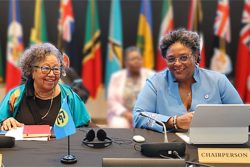On 28 December 2015, we carried an article on the above subject but we were unable to complete it because of space constraints. In that article we referred to Accountability Watch’s four previous articles carried at the beginning of 2015 entitled “2014 an annus horribilis for governance,  transparency and accountability”. In these articles, we had discussed a number of topics including: (a) the prorogation of Parliament; (b) delay in holding Local Government elections; (c) the incurrence of excess expenditure totalling $4.544 billion; (d) non-establishment of the Public Procurement Commission; (e) delay in laying the Auditor General’s 2013 report in the Assembly; (f) the work of the PAC; (g) need for revision of the accountability cycle; (h) amendments to the Anti-Money Laundering and Countering the Financing of Terrorism (AML/CFT) Act; and (i) corruption and the Integrity Commission.
transparency and accountability”. In these articles, we had discussed a number of topics including: (a) the prorogation of Parliament; (b) delay in holding Local Government elections; (c) the incurrence of excess expenditure totalling $4.544 billion; (d) non-establishment of the Public Procurement Commission; (e) delay in laying the Auditor General’s 2013 report in the Assembly; (f) the work of the PAC; (g) need for revision of the accountability cycle; (h) amendments to the Anti-Money Laundering and Countering the Financing of Terrorism (AML/CFT) Act; and (i) corruption and the Integrity Commission.
A year later, we began to revisit these issues and assess the extent to which progress has been made. So far, we discussed the first five topics. Today, we continue our discussion of the remaining topics.
The work of the Public Accounts Committee
The public accountability cycle does not cease with the tabling in the National Assembly of the Auditor General’s report on the public accounts. Once the Assembly receives the report, it refers the report to the Public Accounts Committee (PAC) for detailed examination. The PAC is a select committee of the Assembly established by Standing Order No. 82. The Committee comprises six to ten members in proportion to representation by political parties in the Assembly. The late Harold Wilson, who was the Chairman of the UK PAC, provides some useful guidance on the functioning of the PAC:
The essential fact is that this Committee is a Committee of the House responsible to the House as a whole, and is not a battleground for party faction…. I believe it is true to say that the authority of the Committee is greatly enhanced by its unanimous character and I hope the complete objectivity of its report. It is fair to say that many Honourable Members of both parties have made great endeavours and have sometimes sacrificed personal views to ensure that this shall be so.
It is the duty of the PAC to “examine the accounts showing the appropriation of sums granted by the Assembly to meet public expenditure and such other accounts laid before the Assembly as the Assembly may refer to the Committee together with the Auditor General’s report thereon”. Within 90 days of the presentation of the PAC report to the Assembly, the Government is required to table a Treasury Memorandum setting out what actions it has taken or proposes to take in relation to the recommendations of the PAC.
The Auditor General’s reports up to 2014 have been tabled in the Assembly. However, the PAC is yet to finalise its report for the years 2010 and 2011 which were examined together in an attempt to bring the PAC’s work up-to-date. At this rate, it will take another 2-3 years before the Committee could examine the public accounts for 2014 by which time at least another two years i.e. 2015 and 2016, will be added to PAC’s backlogged work. This Column has suggested that the new PAC examines the 2014 accounts first in order to create the desired effect, bearing in mind that the passage of time erodes the effectiveness of financial reporting. After this is achieved, the backlogged accounts could be dealt with before 30 September 2016 when the next Auditor General’s report is due.
The other disappointment is that the PAC does not examine the accounts of public corporations, other agencies in which controlling interest vests in the State, and statutory bodies. In all probability, these entities are in need of greater scrutiny by the Legislature, as the results of the recently completed forensic audits will bear out. Normanton (1981) made the following interesting observation:
Commonsense would seem to dictate that public accountability based on state audit, should apply to all forms of expenditure, irrespective of when or how they are incurred…It makes little sense to study carefully and continuously the payments which are made through the front door while being obliged to turn a blind eye to the expenditure – which nowadays are often equally large in total – taking place via the back-door…Indeed, the back-door payments are probably in greater need of close surveillance, and more likely to reveal anomalies, questionable policies and transactions…Many big fish, heavily nourished from taxation, swim through unscathed, and their transactions are not systematically studied, except by auditors with no constitutional reporting role…hence the gaps in the front of public accountability are almost totally undefended…In all this, the interest of the taxpayer who foots the bills, is often forgotten.”
In 1993, the Financial Administration and Audit (FAA) Act was amended to extend the Auditor General’s mandate to the audit of public corporations and other entities in which controlling interest vests in the State. This amendment came about because of attempts to marginalize the Audit Office as it relates to the audit of these entities and to give preference to private auditing firms. Concern was also expressed that these entities were deteriorating financially, yet they were given “clean” audit reports. The auditors were also involved in consulting and taxation services for the same entities they were required to audit.
The matter was brought to the attention of the late President Cheddi Jagan who summoned a meeting with the Auditor General and the Minister of Finance. These were his famous words: When I was in Opposition, I wondered why the Auditor General was not involved in the audit of public corporations. As a matter of policy, he must be involved, and if the law does not permit this, we must amend the law. The amendment to the FAA Act (now repealed and replaced by the FMA Act and the Audit Act) was piloted in the Assembly by none other than former president Bharrat Jagdeo in his maiden presentation to the Assembly.
The audited accounts of public corporations and other entities in which controlling interest vests in the State are to be presented to the subject Ministers within six months of the close of the financial year. The Ministers in turn are required to take measures to have these accounts laid in the Assembly within nine months of the close of the financial year. However, there has been a lack of compliance in most cases. When the accounts are eventually laid in the Assembly, neither is there a discussion at the level of the Assembly nor are the accounts referred to the PAC for detailed examination. One hopes that the Assembly will see it fit to have legislation in place to provide for sanctions for the failure to honour the statutory requirements of having timely financial reporting and audit and for the results to be presented to the Assembly within the specified timeframe. The PAC also has to get its act going in terms of fulfilling its responsibilities under Standing Order 82.
Need for revision of the accountability cycle
The current arrangements involve the Accountant General preparing and submitting the draft public accounts to the Auditor General within four months of the close of the financial year and for those accounts to be audited and reported on within nine months of the close of year i.e. by 30 September. This is a time when the Assembly is in recess, and therefore it would be some time in October before the accounts are laid in the Assembly. In addition, during the consideration of the National Budget, Legislators do not have the benefit of the results of the audit of the previous year’s public accounts, which could serve as an important reference point.
The Constitution allows the Government to prepare and present to the Assembly the Estimates of Revenue and Expenditure for a particular financial year, within 90 days of the close of the previous financial year. Moves are being made to have an earlier presentation, hopefully in the long term, before the beginning of the year. For 2016, the Minister of Finance has promised an early budget which will be a welcome development. As regards the entire accountability timeframe, one would hope that similar moves will be made to have an earlier presentation of draft financial statements to the Auditor General and for him to present the results, say, by 30 June. The PAC could begin its examination immediately thereafter and present its findings and recommendations by 30 September. In this way, the Assembly will have the benefit of the availability of audited public accounts for the previous year along with the report of the PAC during the consideration of the Estimates. The entire accountability cycle could therefore be completed within 12 months of the close of the financial year, which could be a significant achievement in Guyana’s public financial management.
Amendments to the AML/CFT Act
Following the 11 May 2015 national and regional elections, one of the first tasks of the new Administration was to address the stalemate relating to the passage of important amendments to the Anti-Money Laundering and Countering the Financing of Terrorism Act. The then present Administration had wanted a comprehensive overhaul of the legislation while the previous Administration insisted on minimal changes based on the deficiencies identified by the Financial Action Task Force (FATF). The new Administration was able to secure the necessary amendments to the Act based on the position it had taken. However, there was need for further amendment, particularly as regards the freezing of assets of persons suspected of being involved in money laundering. This has since been accomplished through a third amendment. Hopefully, it will bring to an end any suggestion that Guyana is not fully in compliance with the requirements set out by FATF.
Corruption and the Integrity Commission
The main pillar in Guyana’s fight against corruption relates to the effective functioning of the Integrity Commission which was established in 1999. In 2006, Bishop George resigned as Chairman of the Commission, and since then there has been no replacement. As a result, the Commission was unable to meet because of the absence of a quorum. Although Ministers of the Government, other Members of Parliament and senior public servants are required to make annual declarations of assets and liabilities to the Commission, compliance has been uneven.
The Commission also lacks investigative capacity to scrutinize the returns and to probe into inconsistencies between the declarations and the perceived lifestyles of the public officials. One hopes that the Prime Minister, whose portfolio now covers governance, will make every effort to ensure that a strong, credible and effective Integrity Commission is in place staffed by independent, competent and professional persons serving as Commissioners, back by a team of highly trained and skilled investigators.









